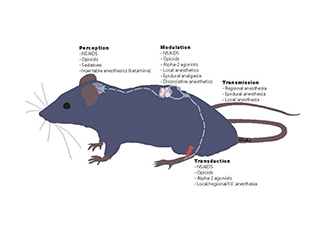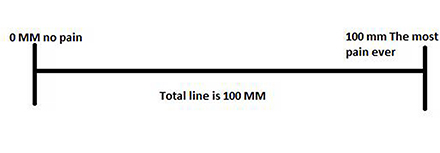Pain management tips and tricks

Pain Management Tips and Tricks
Published on ALN (http://www.alnmag.com)
Pain Management Tips and Tricks
Mary Ellen Goldberg BS, LVT, CVT, SRA, CCRA
What is Pain?
Pain has been called the "fourth vital sign" after body temperature, heart rate, and
respiratory rate, and its potential presence should be evaluated in patients just as
other vital signs.1 Pain is an unpleasant sensory and emotional experience
associated with actual or potential tissue damage, or described in terms of such
damage.2 Pain motivates us to withdraw from potentially damaging situations,
protect a damaged body part while it heals, and avoid those situations in the
future.3 It is initiated by stimulation of nociceptors in the peripheral nervous system,
or by damage to or malfunction of the peripheral or central nervous systems.4 Most
pain resolves promptly once the painful stimulus is removed and the body has
healed, but sometimes pain persists despite removal of the stimulus and apparent
healing of the body; and sometimes pain arises in the absence of any detectable
stimulus, damage, or pathology.5 For the purpose of this session we will describe
pain as acute, chronic, or neuropathic (maladaptive).
What is the Pain Pathway?
The Pain Pathway = Nociception = processing of harmful stimuli in the nervoussystem.6
Nociception refers to the processing of a noxious stimulus resulting in theperception of pain by the brain. The components of nociception includetransduction, transmission, modulation, and perception.
Transduction is the conversion of a noxious stimulus (mechanical, chemical, orthermal) into electrical energy by a peripheral nociceptor (free afferent nerveending).
Drugs that work well here include:
Pain Management Tips and Tricks
Published on ALN (http://www.alnmag.com)
NSAIDS (carprofen, meloxicam, robenacoxib, etc)Opioids (morphine, hydromorphine,etc.)Local Anesthetics (lidocaine, bupivacaine)Corticosteroids (dexemethasone, depo-medrol, prednisone, etc)
Transmission describes the propagation through the peripheral nervous system viafirst-order neurons. Nerve fibers involved include A-delta (fast) fibers responsible forthe initial sharp pain, C (slow) fibers that cause the secondary dull, throbbing pain,and A-beta (tactile) fibers, which have a lower threshold of stimulation.
Drugs that work well here include:
Local Anesthetics (lidocaine, bupivacaine)Alpha-2-agonists (dexmedetomidine, xylazine)
Modulation occurs when first-order neurons synapse with second-order neurons inthe dorsal horn cells of the spinal cord. Excitatory neuropeptides (including, but notlimited to, glutamate, aspartate and substance P) can facilitate and amplify the painsignals in ascending projection neurons. At the same time, endogenous (opioid,serotonergic, and noradrenergic) descending analgesic systems serve to dampenthe nociceptive response.
Drugs that work well here include:
Local Anesthetics (lidocaine, bupivacaine)NSAIDS (carprofen, meloxicam, robenacoxib, etc)Opioids (morphine, hydromorphine,etc.)Alpha-2-agonists dexmedetomidine, xylazine)NMDA Antagonists (ketamine, amantadine)Tricyclic Antidepressants (amitriptyline)Anticonvulsants (gabapentin)
Perception is the cerebral cortical response to nociceptive signals that are projectedby third-order neurons to the brain.
Drugs that work well here include:
Opioids (morphine fentanyl,etc)Alpha-2-agonists (dexmedetomidine, xylazine)General Anesthetics (isoflurane, sevoflurane)Benzodiazepines (diazepam, midazolam)Phenothiazines (acepromazine)
LABORATORY ANIMAL FACILITY DESIGN STRATEGIES:
Pain Management Tips and Tricks
Published on ALN (http://www.alnmag.com)
The 2016 TurnKey Conference offers the right content and strategies for
efficient facility design, construction, renovation, and operation. [1]
Pain Assessment
When determining which analgesics should be used, several factors need to be
considered:
What is the likely severity of pain, and what is its anticipated duration?Which drug or drugs should be administered, and at what dose rates?Are there any special factors that will influence the choice of analgesic, forexample, the species of animal, any potential interactions with a particularresearch protocol, or any particular features of the current condition and thetype of pain?What facilities are available for management of the animal? What level ofnursing care and monitoring of the animal is available? Can staff attendthroughout a 24 hour period? Are there facilities for continuous infusion ofanalgesics?
When left unrelieved, pain in laboratory animals produces a catabolic state, whichmay lead to wasting of muscles. It also suppresses the immune response, which canlead to infection, and promotes inflammation, delaying wound healing. Pain can alsoresult in increased anesthetic risks, because higher doses are required to maintaina stable plane of anesthesia.
move, awkward chronic to
acute, can besubdued orvicious, quiet orrestless
Generally silent, Stiff, hunched in Reluctant to
limbs tuckedunder body
body, huddledcrouching
Ataxia, running Docile or
severity of pain,
Piercing squeal Hunched, faces Inactive, drags Apprehensive,on acute pain
Pain Management Tips and Tricks
Published on ALN (http://www.alnmag.com)
Temperamentaggressivedepending onseverity of pain,eats neonates
Drags hind legs Docile, quiet,
Grunting, nicker Rigid, head
circles "up anddown"movement
Limp, reluctant Disinterested in
From excessive Al four feet
squealing to no close together
move, unable to aggressive
depending onseverity of pain
From excessive Inactive,
tonic immobility miserabledepending on
hiding, anorexia schooling fish,
Limp, reluctant Dull, depressed,
Assessment of pain or distress may be based on many different criteria including:9
Pain Management Tips and Tricks
Published on ALN (http://www.alnmag.com)
Decreased activityAbnormal postures, hunched back, muscle flaccidity or rigidityPoor groomingDecreased food or water consumptionDecreased fecal or urine outputWeight loss (generally 20-25% of baseline), failure to grow, or loss of bodycondition (cachexia)DehydrationDecrease or increase in body temperatureDecrease or increase in pulse or respiratory ratePhysical response to touch (withdrawal, lameness, abnormal aggression,vocalizing, abdominal splinting, increase in pulse or respiration)Teeth grinding (seen in rabbits and farm animals)Self-aggressionInflammationPhotophobiaVomiting or diarrheaObjective criteria of organ failure demonstrated by hematological or bloodchemistry values, imaging, biopsy, or gross dysfunction
What About Pain Scoring?
Pain scoring for laboratory animals has evolved since 1985.10 Being able to
recognize pain and score has become commonplace in veterinary practice.
Researchers, scientists, and their staff are now required to recognize an animal in
pain. Patients should never need to prove that they are in pain. A sound approach
to pain management favors anticipation of the severity and duration of pain that is
likely to occur with any procedure, condition, or surgery.11 Pain assessment is
currently considered to be an essential part of every patient evaluation, regardless
of presenting complaint.
Pain rating scales should include at least three requirements:12
1. Minimal inter-observer variability and observer bias.
2. Ability to distinguish varying levels of pain intensity in a particular species
and situation.
3. Ability to detect the degree of "importance" of pain to the subject.

Pain Management Tips and Tricks
Published on ALN (http://www.alnmag.com)
Pain scales can be visual analog scales (VAS) (Figure 1), numerical rating scales(NRS) (Figure 2), or simple descriptive scales (SDS). For VAS, a line with nomarkings is used, numbers are at each end with 0 meaning no pain and 100 beingworst. The NRS pain scale uses a number line with individual numerical markings(1-10) which are chosen as the score, and during SDS, numbers are used to assignto descriptions that categorize different levels of pain intensity.
Grimace scales have been developed for several species, notably mice, rats,rabbits, and horses. In the mouse grimace scale, intensity of each feature is codedon a three-point scale. For each of the five features, images of mice exhibitingbehavior corresponding to the three values are shown.13 The Rat Grimace Scalequantifies pain in the laboratory rat via facial expressions.14 The Rabbit GrimaceScale can be used to help recognize subtle expressions of pain in rabbits.15 TheHorse Grimace Scale was developed to help with recognition of pain after surgicalprocedures in horses.16
These scales are very helpful however many animals appear stoic. Additionallysome animals will actually look better when you directly observe them.
Conclusion
As those working in a research setting we must:
Have an accurate understanding about what pain is and how it affects anorganismBe able to communicate intelligently and effectively about pain
Pain Management Tips and Tricks
Published on ALN (http://www.alnmag.com)
Be able to Recognize PainBe able to Assess PainBe able to Score Pain"Think outside the box" where pain is concerned
Let's make it our mission to reduce pain in research animals.
1. Goldberg ME "The Fourth Vital Sign in All Creatures Great and Small" The
NAVTA Journal Winter 2010 pg 31-54.
2. International Association for the Study of Pain Retrieved 6 October 2009.
This often quoted definition was first formulated by an IASP Subcommitteeon Taxonomy Bonica, JJ (1979). "The need of a taxonomy". Pain 6 (3):247–252.
3. Lynn, B (1984) "Cutaneous nociceptors" in Holden, AV & Winlow, W The
neurobiology of pain. Manchester, UK: Manchester University Press. p. 106.
4. Woolf, CJ & Mannion, RJ (1999) "Neuropathic pain: aetiology, symptoms,
mechanisms and management". The Lancet 353 (9168): 1959–1064.
5. Raj, PP (2007) "Taxonomy and classification of pain" in Kreitler, S; Beltrutti,
D; Lamberto, A et al. The handbook of chronic pain. New York: Nova SciencePublishers Inc.
6. Loeser, J. D.; Treede, R. D. (2008). "The Kyoto protocol of IASP Basic Pain
Terminology". Pain 137 (3): 473–7.
7. Flecknell, P (1999) "Pain-assessment, alleviation and avoidance in
laboratory animals" ANZCCART News 12 (4) December pp 1-10 pg 4.
8. Thomas, John A., Philip Lerche. Anesthesia and Analgesia for Veterinary
Technicians, 4th Edition. Mosby/Elsevier, St. Louis, MO. 2011. Pg. 208
9. Goldberg ME "The Fourth Vital Sign in All Creatures Great and Small" The
NAVTA Journal Winter 2010 pg 31-54.
10. Morton, D. B. and Griffiths, P. H. M. (1985) Guidelines on the recognition of
pain, distress and discomfort in experimental animals and an hypothesis forassessment. Veterinary Record 116: 431-436.
11. Shaffran N and Grubb T. "Pain Management" in McCurnin's Clinical Textbook
for Veterinary Technicians 7th Edition, Editors: Joanna M. Bassert and DenisM. McCurnin. Saunders/Elsevier, St. Louis, MO, 2010. Pg 859
12. Karas, AZ; Danneman, PJ; Cadillac JM (2008) "Strategies for Assessing and
Minimizing Pain" in Anesthesia and Analgesia in Laboratory Animals (2ndEd). London: Elsevier Inc. p211.
13. Langford DJ et al. Coding facial expressions of pain in the laboratory mouse.
Nature Methods June 2010 7(6) pg 448
14. Sotocinal SG et. al. The Rat Grimace Scale: A partially automated method for
quantifying pain in the laboratory rat via facial expressions. Molecular Pain2011, 7:55 pg 5
15. Keating, Stephanie C. J. et al. Evaluation of EMLA Cream for Preventing Pain
during Tattooing of Rabbits: Changes in Physiological, Behavioural andFacial Expression Responses. PLOS One September 2012 7(9) 1-11.
16. Dalla Costa E, Minero M, Lebelt D, Stucke D, Canali E, Leach M. Development
Pain Management Tips and Tricks
Published on ALN (http://www.alnmag.com)
of the Horse Grimace Scale (HGS) as a Pain Assessment Tool in HorsesUndergoing Routine Castration. PLOS One March 2014 9(3): 1-10.
Mary Ellen Goldberg is a graduate of Harcum College and the University of
Pennsylvania. In 2008, she became the Executive Secretary of the International
Veterinary Academy of Pain Management. Ms. Goldberg has written several books
and contributed to numerous chapters regarding anesthesia, pain management,
and rehabilitation.
Source URL (retrieved on 02/17/2016 - 10:24pm):
Source: http://www.lasec.cuhk.edu.hk/uploads/1/3/5/2/13529582/aln_-_pain_management_tips_and_tricks_-_2016-02-17.pdf
Harvard graphics - cora.prs
LE COMMERCE EN FRANCE GROUPE LOUIS DELHAIZE- PROVERA FRANCE LES AUTRES ENSEIGNES DU GROUPE LE COMMERCE EN FRANCE Cible des " gros", Cora s'en est toujours sortie : " attaquée" successivement par Carrefour puis par Casino, tous deux entrés au capital à hauteur de 42%, respectivement entre 1996 et 2001 et entre 2001 et 2006, Cora les a fait plier, pour conserver, aujourd'hui, 100% de son indépendance
Microsoft word - 5.22-27.doc
j. innov.dev.strategy. 2(2): 22-27 (July 2008) ANTIMICROBIAL SUSCEPTIBILITY OF Salmonella SEROVARS ISOLATED FROM BLOOD M. J. ISLAM1, K. K. DAS2, N. SHARMIN3, M. N. HASAN4 AND A. K. AZAD5 1Lecturer, Department of Pharmacy, University of Development Alternative, Dhanmondi, Dhaka, 2, 3 & 4Lecturer, Department of Biotechnology and Genetic Engineering, 5Assistant professor, Department of Pharmacy, University of Development Alternative, Dhanmondi, Dhaka, Bangladesh.